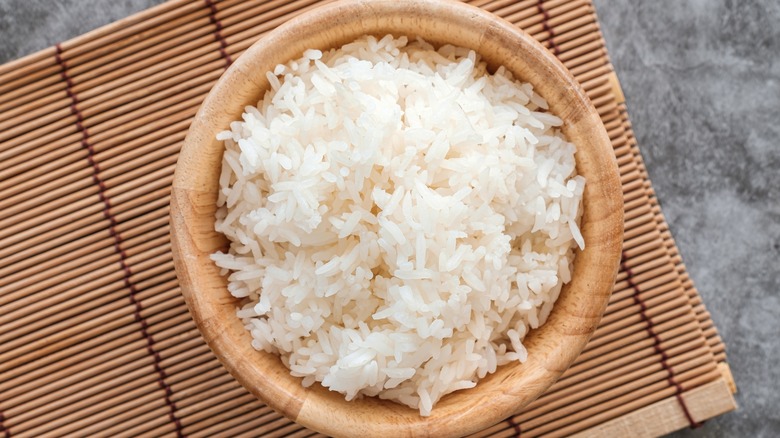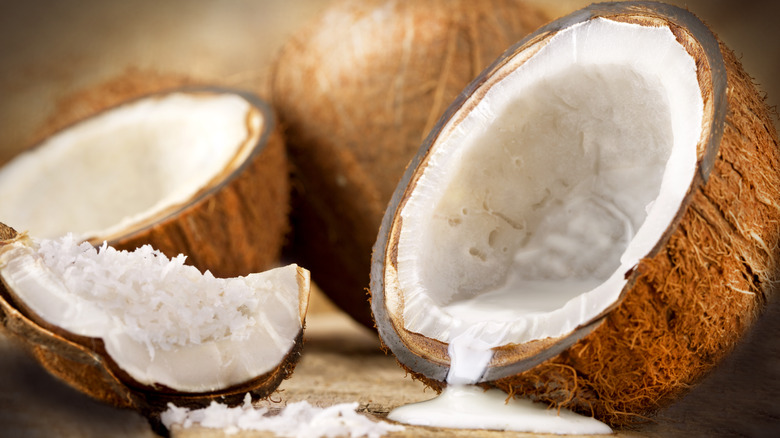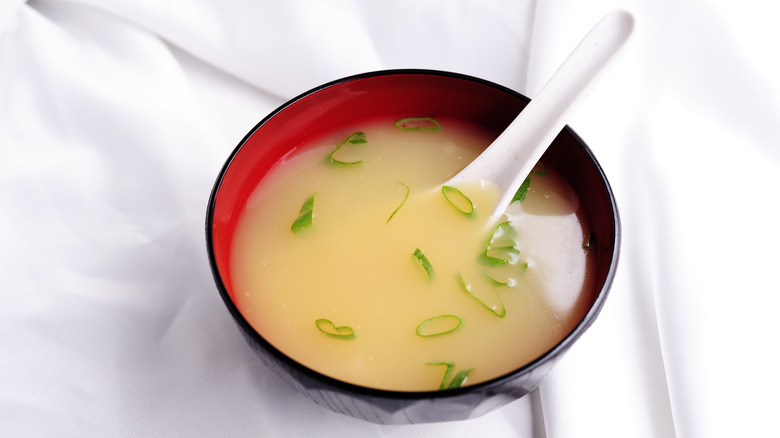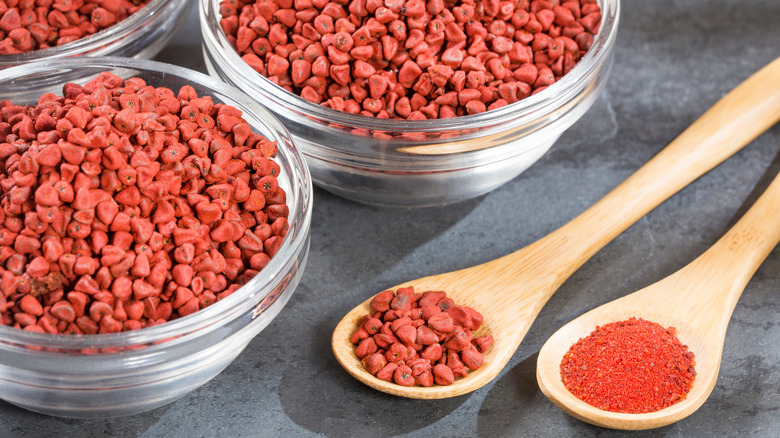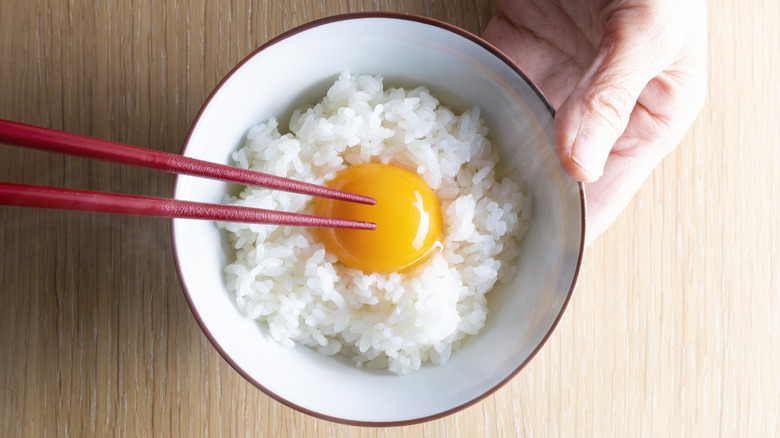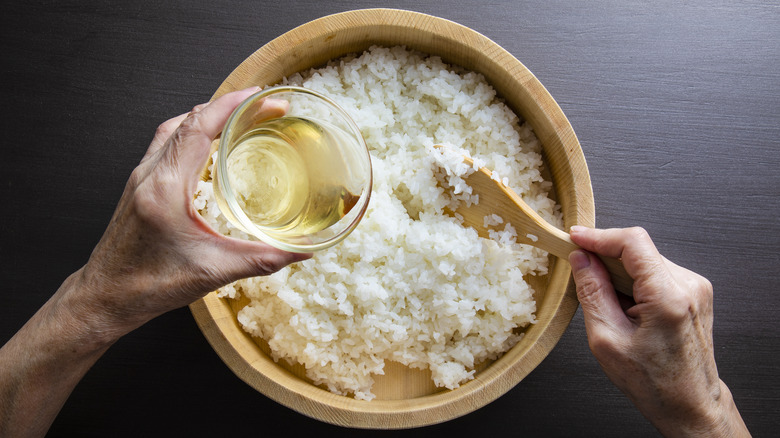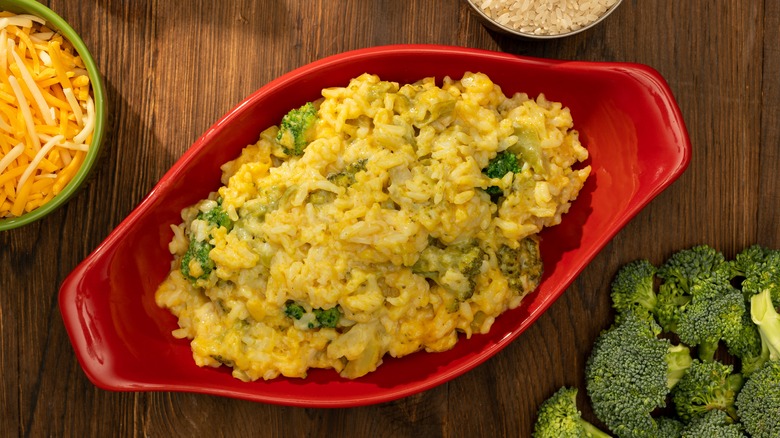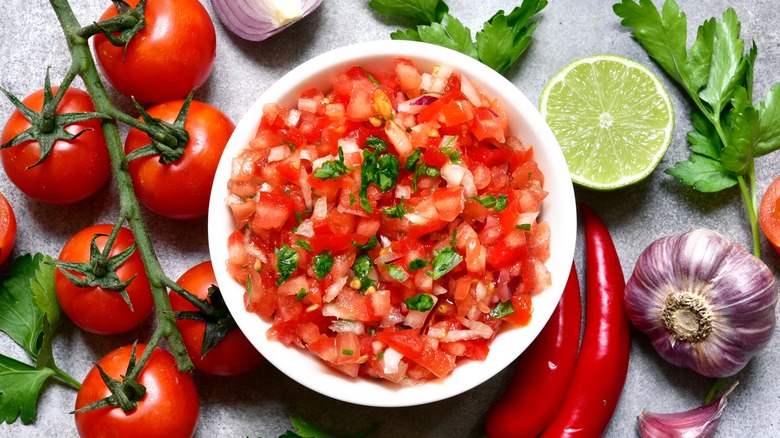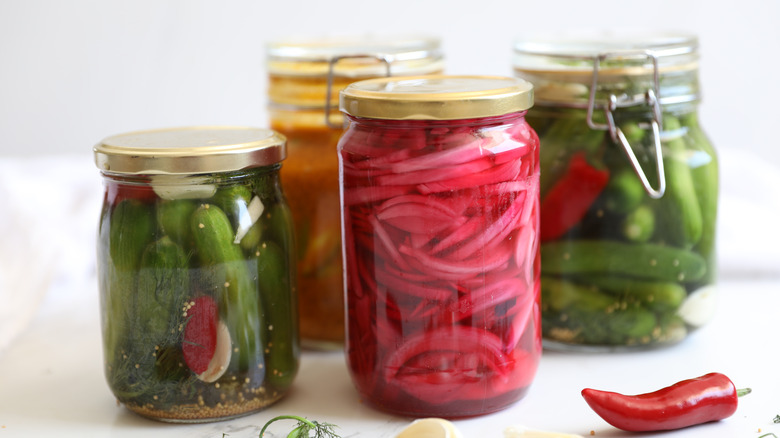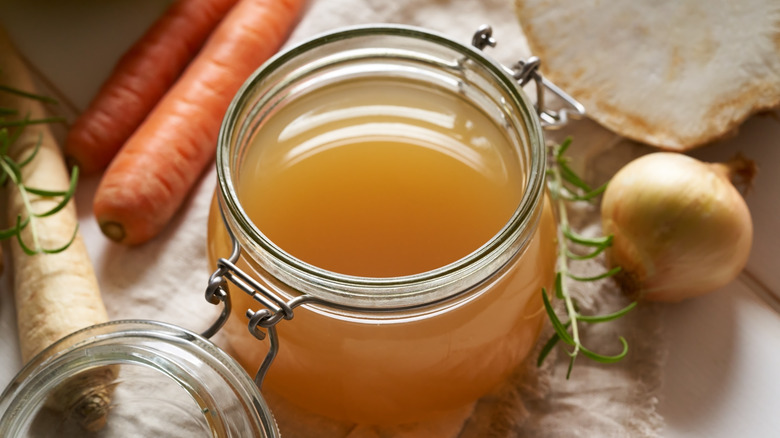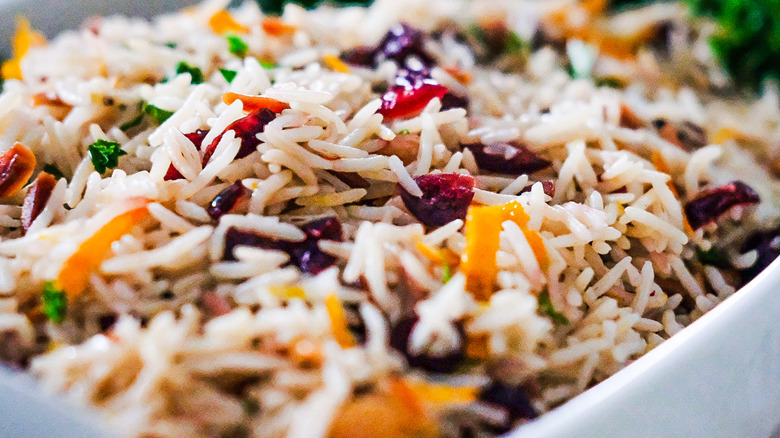12 Rice Additions You Probably Never Thought Of
In many households, rice is always in the pantry because it's inexpensive and easy to make; you don't need any special cooking skills. It's easy to take a bag of rice and put a meal together, whether you choose plain white rice or other varieties like fragrant jasmine or the sticky kind found in sushi. But with any staple, it is easy to get into a rut and make the same few recipes over and over. Luckily, we have some ideas on how to get creative with some rice additions you probably never thought of.
You likely have most of these ingredients in your cupboard or refrigerator; there's no need to reinvent the wheel or make a special trip to the store. Many of these ingredients are inspired by world cuisines and how rice is enjoyed in other parts of the world. So the next time you are making a pot of it, step out of your regular routine and try something different; you may just find a tasty new way to make an old favorite.
1. Orange juice
Orange juice and rice might seem like an odd duo, but the pair make a surprisingly good combination. Try replacing some of the cooking water with the breakfast beverage for sweet, tangy rice. You can eat this on its own, but it really shines when paired with a spicy sauce, stir fry, or curry. Citrus-infused rice is still fairly new to American tastebuds, but is a common side dish in Caribbean cuisine.
Traditionally, fresh squeezed orange juice is used, but if you don't have any oranges, store-bought juice works, too. Ideally, unsweetened is the way to go because juice is naturally sweet and the added sugar can be overkill. Whether you choose pulp or pulp-free won't change the taste, but it will slightly affect the texture. If you aren't a fan of orange juice, other tropical juices like pineapple or mango will give the same touch of sweetness to rice.
2. Coconut milk
By replacing the cooking water in rice for coconut milk you'll enjoy a flavorful and tropical twist on a classic. While the concept of coconut milk in rice might be new to some home cooks, it's a staple in Thai, Caribbean, and Hawaiian cuisines. The distinct taste of coconut rice perfectly complements stir fries and curries, especially when paired with other ingredients like pineapple, lime, and cilantro. It is also a great side dish for seafood and fish.
When it comes to adding coconut milk to your rice, the most convenient option is the canned variety. It's readily available and requires only a can opener, unlike fresh coconut, which can be a bit more challenging to crack open.
When shopping for coconut milk, be careful not to mistake it for coconut water; the two are not interchangeable. Rice made with coconut water will lack the velvety, creamy texture that high fat coconut milk adds.
3. Miso soup
Miso paste, a Japanese seasoning made from fermented soybean paste, is a game-changer for rice as it adds an umami boost. There are two ways to use miso in rice. The first is to make a miso soup and use that as the cooking water; or you can add miso to cooked rice. The former will add flavor without being overpowering, while the latter will have a more concentrated taste.
Miso is available at most supermarkets and international stores, and there are a few different types. White miso is the mildest because it has been fermented for the least amount of time. It is sometimes called sweet miso and often used in sweet dishes as a non-dairy alternative. Adding white miso to rice is a simple way to step into the world of miso without being overwhelmed. Yellow miso is medium-flavored; it is fermented longer than white and is more acidic and salty. Red miso is the darkest and most pungent because of its longer fermentation time.
4. Achiote paste
Turning plain rice into a flavorful dish starts with a spoonful of achiote paste, which is popular in Latin American foods. If you have ever eaten cochinita pibil, then you have tried achiote paste. It tastes slightly earthy and sweet, and is especially good when paired with citrus, like oranges or limes. While it has a slightly peppery bite, it isn't spicy and won't add any unnecessary heat to the rice.
Achiote is made from crushed annatto seeds. While it is most commonly sold as a paste, you can buy it in a powder form, too. The powder will need to be rehydrated with oil before mixing into cooked rice or added to the cooking water; the paste is best added at the end of the cooking process and mixed into the final dish like a condiment. The trick to using achiote is to avoid overdoing it, as it's a potent spice and a little goes a long way.
Achiote-flavored rice makes a great side dish for tacos and enchiladas. You can also make it a main dish by mixing in some protein and veggies or stuffing it into burritos or roasted poblano peppers.
5. Eggs
Eggs are for more than just a breakfast; by adding them to rice, you can turn this side dish into a main course. There are a few different ways you can combine the two, and it just depends on how you like your eggs. If you like them scrambled, then mix the two together for a fried rice-inspired dish. Or, make a thin omelet and slice it into ribbons for a sophisticated yet easy-to-achieve look. If you like them runny with a bright orange yolk, make them fried, poached, or sunny-side-up, then break the yolk and let it ooze out. If you like a cold rice salad, try adding hard-boiled ones to the dish.
Another creative way to use eggs in rice is to use quail eggs instead of chicken eggs. Quail eggs are richer and add a creamier texture. However, if you are on a budget, you might want to skip these little gourmet eggs because they are little more expensive.
6. Vinegar
Vinegar might not seem like a good addition to rice, but there is a good argument for adding it, and it comes down to texture. When it's added to rice, it removes some of the starch and keeps it fluffy, preventing it from sticking together. You only need a small amount of vinegar; one teaspoon mixed with 2 cups of water and 1 cup of rice is enough to do the trick. If you use the classic white version, the taste will have a minimal effect on the rice. However, other types may slightly affect its flavor. For example, apple cider vinegar will add a bit of tartness, and rice vinegar will add a bit of sweetness.
Texture is not the only reason to add vinegar to rice; it can actually make it healthier. According to a study by Medscape General Medicine, it can help reduce the sugar spike that happens when eating high-glycemic foods like rice. Just be careful not to overdo it, though, as adding too much of it can be hard on your teeth and esophagus.
7. Cheese
Cheese is always a good choice to amp up a dish; whether you're slapping it on a burger, sprinkling it over pasta, or mixing it with rice, it just adds something special. A classic creamy risotto with Parmesano Reggiano is one way to pair the two staples. Another is to remake macaroni and cheese by swapping the pasta for rice. For a heartier dish, throw broccoli into the mix and bake it into a casserole. It's easy to mix and match your favorite flavors; just choose any cheese that melts well to get that rich creaminess. Mozzarella, provolone, fontina, gouda, and Swiss are all great options.
Similar to pasta, rice can be served cold, such as in a rice salad caprese. Try making it with salty feta cubes, crumbly blue cheese, or grilled chunks of halloumi. Serve the salad on its own or with your favorite grilled protein for a healthy dinner.
8. White wine
Instead of sipping white wine while cooking, try adding it to your rice. It is an excellent addition as it adds some acidity and depth. The type of dish you are making will determine which wine to use. A classic chardonnay is dry with floral notes, making it a good choice for rice dishes featuring chicken or pork. Sauvignon Blanc is also dry but with citrus undertones that complement rice dishes with seafood and fish. A light, crisp Pinot Gris pairs well with bright, bold flavors like rice curries.
If you are making an Asian-inspired rice dish, use mirin, a sweet rice wine that has a slight tanginess to it. The sugary taste is from the natural fermentation process rather than straight sugar. Adding it to your dish will give it a more complex flavor and slightly shiny presentation. It is commonly added to cooked rice and not the cooking water. Mirin-infused rice pairs well with dishes like poke bowls and teriyaki stir fry. If it's your first time using it, add a little at a time because it can be potent.
9. Salsa
Take your rice dish south of the border with a bright, peppery salsa. Many Mexican restaurants serve entrees with a side of Mexican rice, which is usually made with a mix of tomatoes and onions, as well as spices like cumin and chili powder. You can easily recreate the dish at home by adding some of your favorite salsa to your rice. A smooth, blended tomato-based variety is the best to mimic restaurant rice, but a chunky pico de gallo or green tomatillo-based one would work, too.
Another option is to add some liquid from a can of chipotle peppers in adobo. These flavorful peppers are made from dried, smoked jalapenos and have a rich, smoky taste. You can keep it on the milder side by just adding a tablespoon of the adobo sauce or lean into the heat by adding a couple of chopped peppers. Finish the dish with a sprinkle of fresh cilantro and queso fresco for homemade Mexican rice that is just as good as the restaurant version.
10. Brine
Vegetable brine is a flavorful condiment that can be used to flavor rice in two ways. The first is to replace some of the cooking water with it, and the second is to flavor the rice after it is cooked. The type of brine and the flavor profile of the rice dish will determine which method is best.
Olive brine is great if you are using Mediterranean flavors, and artichoke brine will work best with Italian-inspired rice dishes. Banana peppers or other spicy brines are great for rice dishes that need heat, while pickled red onion brine is good for a rice filling in stuffed peppers or burritos.
While brined vegetables are readily available, from giardinia to capers to roasted peppers, there's something special about making your own. You can tailor the spices to your liking, ensuring a truly personalized flavor experience. Whether you opt for a quick brine with vinegar or a lacto-fermented variety, both are easy to make. Lacto-fermented brine is more time-consuming, but it offers a host of health benefits. According to the medical journal, Nutrients, lacto-fermented foods can aid in reducing inflammation, boost the immune system, and support overall gut health.
11. Broth
Swapping cooking water for savory broth is one of the easiest ways to infuse more flavor into your rice. Chicken broth is a classic choice for lighter sides, while beef broth is excellent for heavier dishes. Vegetable broth is perfect for vegetarian and vegan rice, and fish broth can really amp up the flavor by adding depth to a dish.
Although convenient to use, canned broth often has high levels of sodium. Luckily, homemade broth is easier to make than you might think; just throw your ingredients in a stock pot and boil them down for a simple broth. You can use cheaper cuts of meat, leftover rotisserie chicken bones, or vegetable scraps like carrot and potato peelings or onion and celery ends to add flavor. Use the savory broth to cook your favorite rice before adding it to other dishes or turn it into a healthy vegetable and rice soup. You will love the boost of umami that broth brings to this carbohydrate.
12. Dried fruits and nuts
Turn a plain rice dish into a tasty rice pilaf with dried fruits and nuts. While this may seem like an odd mix, the sweet and savory combination mixed with the classic carbohydrate is a common way to enjoy rice in other cuisines. Try a combination of dried cranberries and walnuts, slivered almonds and apricots, or apples and pumpkin seeds, and see how these unexpected add-ins can amp up a pilaf.
Rice doesn't always have to be savory; you can turn it into a dessert, too. Make an easy, creamy rice pudding with milk, sugar, and warming spices, and sprinkle it with bits of dried fruit and nuts. You can even replace your morning oatmeal with this sweet rice porridge to keep you fueled all day.
